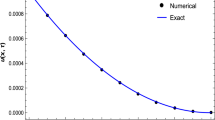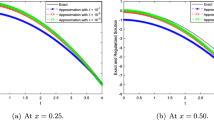Abstract
We examine pattern formations of the spatiotemporal dynamics of tumor growth model. The system is modeled by three-species reaction–diffusion equations of healthy cells, cancer cells and acid concentrations. The equilibrium points of the model are determined, the Routh–Hurwitz criteria allowed us to assess the stability of the system by deducing the conditions of existence of Turing models. Numerical results are presented in order to appreciate how biological processes have been affected by the formation of spatiotemporal patterns and highlight the impact of diffusion term on areas of healthy cells, cancer cells and acid concentrations through Turing and non-Turing models. Our results may be used to better describe the relationship between acidity and pattern formation as metastases during tumor growth through different sequence of diffusive cancer dynamics.













Similar content being viewed by others
Data Availability Statement
This manuscript has associated data in a data repository [Authors’ comment: The datasets generated during and/or analysed during the current study are available from the corresponding author on reasonable request.]
References
H. Sung, J. Ferlay, R.L. Siegel, M. Laversanne, I. Soerjomataram, A. Jemal, F. Bray, Global cancer statistics 2020: GLOBOCAN estimates of incidence and mortality worldwide for 36 cancers in 185 countries. CA Cancer J. Clin. 71(3), 209–249 (2021)
A. Abduvaliev, M. Saydalieva, M. Hidirova, M. Gildieva, Mathematical modeling of the thyroid regulatory mechanisms. Am. J. Med. Sci. Med. 3(3), 28–32 (2015)
S.S. Hori, S.S. Gambhir, Mathematical model identifies blood biomarker-based early cancer detection strategies and limitations. Sci. Transl. Med. 3, 109–16 (2011)
K. Park, A review of modeling approaches to predict drug response in clinical oncology. Yonsei Med. J. 58(1), 1–8 (2017)
L.T. Jackson, A mathematical model of prostate tumor growth and androgen independent relapse. Disc Cont. Dyn. Syst. B 4, 187–201 (2004)
D.S. Rodrigues, P.F.A. Mancera, T.R.P. Suani, Understanding the antiangiogenic effect of metronomic chemotherapy through a simple mathematical model. Phys. A 464, 251–66 (2016)
W.E. Boyce, R. DiPrima, Elementary Differential Equations and Boundary Value Problems (Wiley, Hoboken, 2012)
M.W. Hirsh, S. Smale, R.L. Devaney, Differential Equations, Dynamical Systems and an Introduction to Chaos (Elsevier, Amsterdam, 2004)
V.A. Kuznetsov, I.A. Makalkin, M. Taylor, A.S. Perelson, Nonlinear dynamics of immunogenic tumors: parameter estimation and global bifurcation analysis. Bull. Math. Biol. 56(2), 295–321 (1994)
A.J. Adam, Effects of vascularization on lymphocyte/tumor cell dynamics: qualitative features. Math. Comput. Model. 23(6), 1–10 (1996)
R. De Boer, P. Hogeweg, H. Dullens, A.R. De Weger, W. Den Otter, Macrophage lymphocyte interactions in the anti-tumor immune response: a mathematical model. J. Immunol. 134(4), 2748–2758 (1985)
D. Kirschner, C.J. Panetta, Modeling immunotherapy of the tumor-immune interaction. J. Math. Biol. 37(3), 235–252 (1998)
S. Banerjee, R. Sarkar, Delay-induced model for tumor-immune interaction and control of malignant tumor growth. Biosystems 91(1), 268–288 (2008)
R. Eftimie, L.J. Bramson, D.J. Earn, Interactions between the immune system and cancer: a brief review of non spatial mathematical models. Bull. Math. Biol. 73(1), 2–32 (2011)
J. Adam, A. Corrigendum, A mathematical model of tumor growth by diffusion. Math. Biosci. 94, 155 (1989)
M.A.J. Chaplain, F.N. Britton, On the concentration profile of a growth inhibitory factor in multicell spheroids. Math. Biosci. 115, 233–245 (1993)
M.A.J. Chaplain, M.A. Stuart, A mathematical model for the diffusion of tumour angiogenesis factor into the surrounding host tissue. IMA J. Math. Appl. Med. Biol. 8, 191–220 (1991)
P. Esfahani, H. Levine, M. Mukherjee, B. Sun, Three-dimensional cancer cell migration directed by dual mechanochemical guidance. Phys. Rev. Res. 4, L022007 (2022)
P. Zhivkov, J. Waniewski, Modelling tumour-immunity interactions with different stimulation functions. Int. J. Appl. Math. Comput. Sci. 13(3), 307 (2003)
R. Lefever, W. Horsthemke, Bistability in fluctuating environments. Implications in tumor immunology. Bull. Math. Biol. 41, 469 (1979)
R.P. Garay, R. Lefever, A kinetic approach to the immunology of cancer: stationary states properties of efffector-target cell reactions. J. Theor. Biol. 73, 417 (1978)
M.A.J. Chaplain, M. Ganesh, G.I. Graham, Spatio-temporal pattern formation on spherical surfaces: numerical simulation and application to solid tumour growth. J. Math. Biol. 42, 387–423 (2001)
P. Domschke, D. Trucu, A. Gerisch, M.A.J. Chaplain, Mathematical modelling of cancer invasion: implications of cell adhesion variability for tumour infiltrative growth patterns. J. Theor. Biol. 21(361), 41–60 (2014)
R.H. Thomlinson, H.L. Gra, The histological structure of some human lung cancers and the possible implications for radiotherapy. Br. J. Cancer 9, 539–549 (1955)
R.A. Gatenby, J.R. Gillies, Why do cancers have high aerobic glycolysis. Nat. Rev. Cancer 4, 891–899 (2004)
R.J. Gillies, N. Raghunand, G.S. Karczmar, M.Z. Bhujwalla, MRI of the tumor microenvironment. J. Magn. Reson. Imag. 16, 430–450 (2002)
H. Wang, Q. Xi, G. Wu, Fatty acid synthase regulates invasion and metastasis of colorectal cancer via Wnt signaling pathway. Cancer Med. 5(7), 1599–606 (2016)
D.A. Fishman, Y. Liu, S.M. Ellerbroek, M. Sharon Stack, Lysophosphatidic acid promotes matrix metalloproteinase (MMP) activation and MMP-dependent Invasion in ovarian cancer cells. Cancer Res. 61, 3194–3199 (2001)
L. Liao, C. Liu, X. Xie, J. Zhou, Betulinic acid induces apoptosis and impairs migration and invasion in a mouse model of ovarian cancer. J. Food Biochem. 44, e13278 (2020)
Y. Chen, W. Xiongjian, C. Liu, Y. Zhou, Betulinic acid triggers apoptosis and inhibits migration and invasion of gastric cancer cells by impairing EMT progress. Cell Biochem. Funct. 38, 702–709 (2020)
A. Silvia, Acid-mediated tumor invasion as a function of nutrient source location. Phys. Rev. E 100, 022417 (2019)
P.K. Maini, K.J. Painter, H.N.P. Chau, Spatial pattern formation in chemical and biological systems. J. Chem. Soc. Faraday Trans. 93, 3601–3610 (1997)
M.-W. Takuma Hoshino, W.K.-A. Liu, H.-Y. Chen, T. Tsuruyama, S. Komura, Phys. Rev. E 99, 032416 (2019)
Q. Zheng, J. Shen, Dynamics and pattern formation in a cancer network with diffusion. Commun. Nonlinear Sci. Numer. Simul. 27, 93–109 (2015)
O. Warburg, The Metabolism of Tumours (Constable Press, London, 1930)
O. Warburg, On the origin of cancer cells. Science 123, 309–314 (1956)
N. McCarthy, Metabolism: room to breathe. Nat. Rev. Cancer 9, 13 (2009)
R.J. DeBerardinis, J.J. Lum, G. Hatzivassiliou, C.B. Thompson, The biology of cancer: metabolic reprogramming fuels cell growth and proliferation. Cell Metabol 7, 11–20 (2008)
R.A. Gatenby, R.J. Gillies, Why do cancers have high aerobic glycolysis. Nat. Rev. Cancer 4(11), 891–899 (2004)
K. Smallbone, D. Gavaghan, R.A. Gatenby, P.K. Maini, The role of acidity in solid tumour growth and invasion. J. Theor. Biol. 235(4), 476–484 (2005)
R. Venkatasubramanian, M.A. Henson, N.S. Forbes, Incorporating energy metabolism into a growth model of multicellular tumor spheroids. J. Theor. Biol. 242, 440–453 (2006)
L. Bianchini, A. Fasano, A model combining acid-mediated tumour invasion and nutrient dynamics. Nonlinear Anal. Real World Appl. 10(4), 1955–1975 (2009)
A. Bertuzzi, A. Fasano, A. Gandolfi, C. Sinisgalli, Necrotic core in EMT6/Ro tumour spheroids: is it caused by an ATP deficit. J. Theor. Biol. 262, 142–150 (2010)
R.A. Gatenby, E.T. Gawlinski, A reaction-diffusion model of cancer invasion. Cancer Res. 56(24), 5745–5753 (1996)
S. Gakkhar, K. Gupta, A three species dynamical system involving prey-predation, competition and commensalism. Appl. Math. Comput. 237, 54–67 (2016)
B. Tamko Mbopda, S. Issa, S. Abdoulkary, R. Guiem, H. Fouda, P. Ekobena, Pattern formations in nonlinear dynamics of hepatitis B virus. Eur. Phys. J. Plus 136, 586 (2021)
J. Lia, G.-Q. Sunb, Z. Jin, Pattern formation of an epidemic model with time delay. Phys. A 403, 100–109 (2014)
G.-Q. Sun, Pattern formation of an epidemic model with diffusion. Nonlinear Dyn. 69, 1097–1104 (2012)
Acknowledgements
The authors would like to thank the Editor and to the anonymous Referees for their valuables remarks and suggestions which help us to improve the quality of the present paper.
Author information
Authors and Affiliations
Corresponding author
Rights and permissions
About this article
Cite this article
Issa, S., Mbopda, B.T., Kol, G.R. et al. Diffusive pattern formations in three-species nonlinear dynamics of cancer. Eur. Phys. J. Plus 138, 496 (2023). https://doi.org/10.1140/epjp/s13360-023-04048-4
Received:
Accepted:
Published:
DOI: https://doi.org/10.1140/epjp/s13360-023-04048-4




